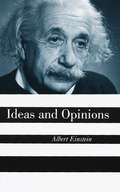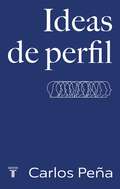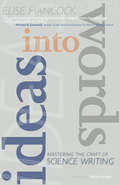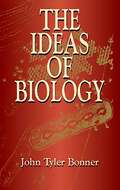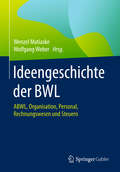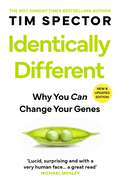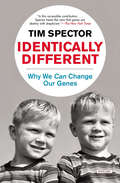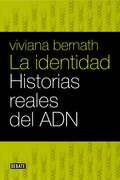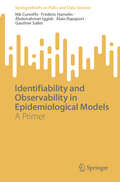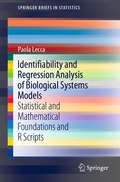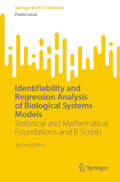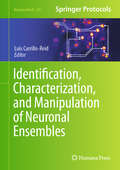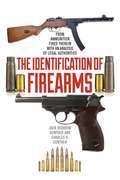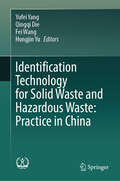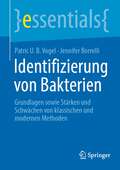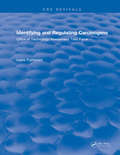- Table View
- List View
Ideas And Opinions
by Albert EinsteinA new edition of the most definitive collection of Albert Einstein's popular writings, gathered under the supervision of Einstein himself. The selections range from his earliest days as a theoretical physicist to his death in 1955; from such subjects as relativity, nuclear war or peace, and religion and science, to human rights, economics, and government.From the Trade Paperback edition.
Ideas and Opinions
by Albert EinsteinFrom one of the world's most important and enduring minds, Albert Einstein's ideas, thoughts, and philosophies on the world and its people. Copyright © Libri GmbH. All rights reserved.
Ideas de perfil
by Carlos PeñaUn deslumbrante repaso por la vida y obra de los más importantes pensadores contemporáneos. En este contundente libro Carlos Peña presenta un conjunto de perfiles que ahondan en las vidas y obras de los principales pensadores de la modernidad. Con claridad y distinción, el destacado ensayista chileno se pasea por las ideas de Maquiavelo, Kant, Freud, Sartre, De Beauvoir, Arendt, Kristeva, Heidegger, Wittgenstein, Zizek y una decena de filósofos, sociólogos, políticos y psicoanalistas. Utilizando el género del perfil para iluminar los claroscuros de las vidas y obras analizadas, Peña se presenta a los lectores en este nuevo libro como lector riguroso e incisivo, definiciones que han caracterizado su rol como intelectual público.
Ideas into Words: Mastering the Craft of Science Writing
by Elise Hancock"I am so proud to be Elise's student. Read this book and I suspect you will be too."—from the foreword by Robert Kanigel, author of The Man Who Knew InfinityFrom the latest breakthroughs in medical research and information technologies to new discoveries about the diversity of life on earth, science is becoming both more specialized and more relevant. Consequently, the need for writers who can clarify these breakthroughs and discoveries for the general public has become acute. In Ideas into Words, Elise Hancock, a professional writer and editor with thirty years of experience, provides both novice and seasoned science writers with the practical advice and canny insights they need to take their craft to the next level. Rich with real-life examples and anecdotes, this book covers the essentials of science writing: finding story ideas, learning the science, opening and shaping a piece, polishing drafts, overcoming blocks, and conducting interviews with scientists and other experts who may not be accustomed to making their ideas understandable to lay readers. Hancock's wisdom will prove useful to anyone pursuing nonfiction writing as a career. She devotes an entire chapter to habits and attitudes that writers should cultivate, another to structure, and a third to the art of revision. Some of her advice is surprising (she cautions against slavish use of transitions, for example); all of it is hard-earned, astute, and wittily conveyed. This concise guide is essential reading for every writer attempting to explain the world of science to the rest of us.
The Ideas of Biology (Dover Books on Biology)
by John Tyler Bonner"The great achievement of this book," observed the distinguished science writer Gerald Wendt, "is that it presents the basic concepts of biology in concise, lucid, orderly form and thus gradually and understandably transforms the miracle of life into a succession of miraculously simple processes." John Tyler Bonner's series of concise essays explores the foundations of modern biology: the cell, genetics, development, and evolution. "Biologists are fortunate in having such a scientist and author interpret these facts, for Dr. Bonner's style of writing contributes greatly to the success of the work," noted Library Journal, adding, "The drawings which accompany the text are excellent." Since evolution provides the framework for life, the author makes it his central theme, with introductory material on the living machine itself and succeeding chapters on heredity, embryonic development, and ultimately, relations between organisms and their environment. Written as a supplement to classroom biology texts, this volume can be read independently.
The Ideas of Particle Physics
by James E. Dodd Ben GripaiosThis book is a comprehensive introduction to particle physics, bridging the gap between traditional textbooks on the subject and popular accounts that assume little background knowledge. This fourth edition is fully revised, including the most recent ideas and discoveries, and the latest avenues of research. The development of the subject is traced from the foundations of quantum mechanics and relativity, through the formulation of quantum field theories, to the standard model. Research now continues with the first signs of physics beyond the standard model and with the formulation of modern string theory which aims to include a quantum theory of gravity for the first time. This book is intended for anyone with a background in physical sciences who wishes to learn about particle physics. It is also valuable to students of physics wishing to gain an introductory overview of the subject.
Ideengeschichte der BWL: ABWL, Organisation, Personal, Rechnungswesen und Steuern
by Wenzel Matiaske Wolfgang WeberDieses Buch erläutert und entwickelt das Profil der Betriebswirtschaftslehre weiter und liefert wichtige Beiträge zur Ideengeschichte der Betriebswirtschaftslehre. Das Buch konzentriert sich dabei insbesondere auf die Gebiete Organisation, Personal, Rechnungswesen, Steuern und Allgemeine Betriebswirtschaftslehre. Gegenwärtig zeichnet sich die Möglichkeit ab, dass sich die fachlichen Teilgebiete der Betriebswirtschaftslehre verselbständigen. Dazu trägt auch, aber nicht nur, das mittlerweile weltweit dominierende angelsächsische Verständnis des Faches bei, das durch eine weitgehende Zersplitterung der betriebswirtschaftlichen Teilgebiete gekennzeichnet werden kann. In der deutschsprachigen Betriebswirtschaftslehre besteht deshalb seit einigen Jahren das wieder entfachte Interesse und Bemühen, wichtige Beiträge zu der Ideengeschichte der Betriebswirtschaftslehre und den Wurzeln des Faches in das wissenschaftliche Bewusstsein zu rücken. Dieses Buch leistet dazu einen wichtigen Beitrag. Die Autoren identifizieren und diskutieren markante Ideen und Beiträge zur Entwicklung des Faches. Neben dem Blick zurück wird auch der aktuelle Zustand des Faches betrachtet. Auf dieser Grundlage werden denkbare weitere Entwicklungslinien von den Autoren abgeleitet.
Identically Different: Why You Can Change Your Genes
by Professor Tim Spector'This is not simply a book of ideas, it is also a book of stories, most astounding, many heartbreaking' - Bryan Appleyard, SUNDAY TIMESSince the discovery of DNA, scientists have believed that genes are fixed entities that cannot be changed by environment - we inherit them, pass them on to our children and take them with us when we die.Professor Tim Spector reveals how the latest genetic research and his own pioneering studies on epigenetics are rewriting everything we thought we knew about genes, identity and evolution. Conceptually, he explains, our genes are not fixed entities but more like plastic, able to change shape and evolve, and these changes can be passed on to future generations.Tim Spector's dazzling guide to the hidden world of our genes reveals the complex role they play in shaping our identities, and will make you think again about everything from sexuality to religion, cancer to autism, politics to pubic hair, clones to bacteria, and what it is that makes us all so unique and quintessentially human.
Identically Different: Why You Can Change Your Genes
by Professor Tim Spector'This is not simply a book of ideas, it is also a book of stories, most astounding, many heartbreaking' - Bryan Appleyard, SUNDAY TIMESSince the discovery of DNA, scientists have believed that genes are fixed entities that cannot be changed by environment - we inherit them, pass them on to our children and take them with us when we die.Professor Tim Spector reveals how the latest genetic research and his own pioneering studies on epigenetics are rewriting everything we thought we knew about genes, identity and evolution. Conceptually, he explains, our genes are not fixed entities but more like plastic, able to change shape and evolve, and these changes can be passed on to future generations.Tim Spector's dazzling guide to the hidden world of our genes reveals the complex role they play in shaping our identities, and will make you think again about everything from sexuality to religion, cancer to autism, politics to pubic hair, clones to bacteria, and what it is that makes us all so unique and quintessentially human.
Identically Different: Why You Can Change Your Genes
by Tim Spector'This is not simply a book of ideas, it is also a book of stories, most astounding, many heartbreaking' - Bryan Appleyard, SUNDAY TIMESSince the discovery of DNA, scientists have believed that genes are fixed entities that cannot be changed by environment - we inherit them, pass them on to our children and take them with us when we die.Professor Tim Spector reveals how the latest genetic research and his own pioneering studies on epigenetics are rewriting everything we thought we knew about genes, identity and evolution. Conceptually, he explains, our genes are not fixed entities but more like plastic, able to change shape and evolve, and these changes can be passed on to future generations.Tim Spector's dazzling guide to the hidden world of our genes reveals the complex role they play in shaping our identities, and will make you think again about everything from sexuality to religion, cancer to autism, politics to pubic hair, clones to bacteria, and what it is that makes us all so unique and quintessentially human.
Identically Different: Why We Can Change Our Genes
by Tim SpectorIn this book, a geneticist who studies identical twins &“treats the view that genes are destiny with skepticism&” (The New York Times). How much are the things you choose to do every day determined by your genes and how much is your own free will? Drawing on his own cutting-edge research of identical twins, leading geneticist Tim Spector shows us how the same upbringing, the same environment, and even the same exact genes can lead to very different outcomes. Thought-provoking, entertaining, and enlightening, Identically Different helps us understand the science behind what makes each of us unique and so quintessentially human.
La identidad: Historias reales del ADN
by Viviana BernathA través de 22 inquietantes historias reales en las cuales está en juegoel problema de la identidad, la autora nos sumerge en el mundo de lagenética y del ADN, cuyo descubrimiento fue un hito científico del sigloXX y marcó un punto de inflexión en la historia de la humanidad. Hace meses que Fabián está de novio con Marcela, una chica de 22 añosque le ha permitido volver a sentir el amor y la vitalidad de sujuventud. La relación se va afianzando, hasta que la madre de la jovenirrumpe en la escena. No solo es un antiguo amor de Fabián, sino quesiembra una terrible duda: él podría ser el padre biológico de Marcela.Para desentrañar la verdad no bastan las palabras de quien ha mentidodurante tantos años; solo una prueba de ADN le dará a la pareja larespuesta, a partir de la cual ambos podrán decidir el rumbo de susvidas.El descubrimiento de la prueba de ADN transformó radicalmente la vida delas personas en el siglo XX. Pero, así como la prueba es contundente,demuestra también que la identidad no se limita a la filiación. A laspreguntas de quiénes somos y de dónde venimos se suman hoycuestionamientos sobre cuáles son los verdaderos vínculos familiares,hasta dónde las pruebas científicas modifican los sentimientos de laspersonas, cuál es el límite entre la seguridad y la intimidad. Se tratade un libro apasionante y conmovedor que abre un debate necesario.
Identifiability and Observability in Epidemiological Models: A Primer (SpringerBriefs on PDEs and Data Science)
by Alain Rapaport Nik Cunniffe Frédéric Hamelin Abderrahman Iggidr Gauthier SalletThis book introduces the concepts of identifiability and observability in mathematical epidemiology, as well as those of observers’ constructions. It first exposes and illustrates on several examples the mathematical definitions and properties of observability and identifiability. A chapter is dedicated to the well-known Kermack McKendrick model, for which the complete analysis of identifiability and observability is not available in the literature. Then, several techniques of observer constructions, in view of online estimation of state and parameters, are presented and deployed on several models. New developments relevant for applications in epidemiology are also given. Finally, practical considerations are discussed with data and numerical simulations related to models previously analysed in the book. The book will be appealing to epidemiological modellers and mathematicians working on models in epidemiology.This book contributes to Sustainable Development Goal 3 (SDG3): Good Health and Well Being.
Identifiability and Regression Analysis of Biological Systems Models: Statistical and Mathematical Foundations and R Scripts (SpringerBriefs in Statistics)
by Paola LeccaThis richly illustrated book presents the objectives of, and the latest techniques for, the identifiability analysis and standard and robust regression analysis of complex dynamical models. The book first provides a definition of complexity in dynamic systems by introducing readers to the concepts of system size, density of interactions, stiff dynamics, and hybrid nature of determination. In turn, it presents the mathematical foundations of and algorithmic procedures for model structural and practical identifiability analysis, multilinear and non-linear regression analysis, and best predictor selection.Although the main fields of application discussed in the book are biochemistry and systems biology, the methodologies described can also be employed in other disciplines such as physics and the environmental sciences. Readers will learn how to deal with problems such as determining the identifiability conditions, searching for an identifiable model, and conducting their own regression analysis and diagnostics without supervision. Featuring a wealth of real-world examples, exercises, and codes in R, the book addresses the needs of doctoral students and researchers in bioinformatics, bioengineering, systems biology, biophysics, biochemistry, the environmental sciences and experimental physics. Readers should be familiar with the fundamentals of probability and statistics (as provided in first-year university courses) and a basic grasp of R.
Identifiability and Regression Analysis of Biological Systems Models: Statistical and Mathematical Foundations and R Scripts (SpringerBriefs in Statistics)
by Paola LeccaThis richly illustrated book presents the latest techniques for the identifiability analysis and standard and robust regression analysis of complex dynamical models, and looks at their objectives. It begins by providing a definition of complexity in dynamic systems, introducing the concepts of system size, density of interactions, stiff dynamics, and the hybrid nature of determination. The discussion then turns to the mathematical foundations of model structural and practical identifiability analysis, multilinear and non-linear regression analysis, and best predictor selection, and their algorithmic procedures. Although the featured examples mainly focus on applications to biochemistry and systems biology, the methodologies described can also be employed in other disciplines such as physics and the environmental sciences. Readers will learn how to determine identifiability conditions, how to search for an identifiable model, and how to conduct their own regression analysis and diagnostics without supervision. This new edition includes a concise, yet comprehensive treatment of the main artificial intelligence methods which can be used for parameter inference in models of complex dynamic biological systems. It emphasizes the most efficient solutions for generating synthetic data that augment the training data and which are indispensable for machine learning procedures. Featuring a wealth of real-world examples, exercises, and R codes, the book addresses the needs of doctoral students and researchers in bioinformatics, bioengineering, systems biology, biophysics, biochemistry, the environmental sciences and experimental physics. Familiarity with the fundamentals of probability and statistics (as provided in first-year university courses) and a basic grasp of R are assumed.
Identification and Characterization of Neural Progenitor Cells in the Adult Mammalian Brain
by Sara Gil-Perotín Jose Manuel Garcia-Verdugo Arturo Alvarez-BuyllaAdult neurogenesis has been questioned for many years. In the early 1900s, a dogma was established that denied new neuron formation in the adult brain. In the last century however, new discoveries have demonstrated the real existence of proliferation in the adult brain, and in the last decade, these studies led to the identification of neural stem cells in mammals. Adult neural stem cells are undifferentiated cells that are present in the adult brain and are capable of dividing and differentiating into glia and new neurons. Newly formed neurons terminally differentiate into mature neurons in the olfactory bulb and the dentate gyrus of the hippocampus. Since then, a number of new research lines have emerged whose common objective is the phenotypical and molecular characterization of brain stem cells. As a result, new therapies are successfully being applied to animal models for certain neurodegenerative diseases or stroke. At present, and in years to come, this finding extends to the adult human brain, and gives reason and hope to all the previous studies.
Identification and Mitigation of Large Landslide Risks in Europe: Advances in Risk Assessment
by C. Bonnard F. Forlati C. ScaviaLarge landslides affect many mountain valleys in Europe. They are characterised by a low probability of evolution into a catastrophic event but can have very large impacts on population, infrastructures and the environment. This impact is becoming more and more pronounced due to increasing tourism and the construction of new roads and railways in m
Identification, Characterization, and Manipulation of Neuronal Ensembles (Neuromethods #215)
by Luis Carrillo-ReidThis volume looks at the latest advancements made in the study of neuronal ensembles and their role in brain processes. The chapters in this book cover topics such as approaches to implementing multisensory experiments including the basics of head fixation and analysis of laminar electrophysiology; dimensionality reduction algorithms and network analysis applications for neuronal population recordings; the use of graph theory to detect groups of neurons in optical recordings with high levels of coactivity; tagging and manipulation techniques using optogenetic and chemogenetic approaches to study memory engrams; and methods to characterize molecular signatures of neuronal ensembles using spatially defined transcriptomics. In the Neuromethods series style, chapters include the kind of detail and key advice from the specialists needed to get successful results in your laboratory. Authoritative and comprehensive, Identification, Characterization, and Manipulation of Neuronal Ensembles is a valuable resource for all researchers who are interested in learning more about neuronal population dynamics.
Identification Guide of Freshwater Macroinvertebrates of Spain
by David Galicia Javier Oscoz Rafael MirandaAs a result of the European Commission's concern for the status of continental waters, and as a clear reflection of the notion of water as heritage to be conserved, in the year 2000 the Water Framework Directive (2000/60/CE) was enacted, its goal being to establish a framework to protect water and the different aquatic ecosystems by requiring the Member States to achieve a good ecological status in all their waters by 2015. Like all ecosystems, freshwater ecosystems undergo physical, chemical and energy-related changes, both of natural and anthropogenic origin. These disturbances affect the organisms living in them and those who utilize their resources. Therefore, evaluating these changes has become a very important task in order to better understand aquatic systems. The study and analysis of the ecological status of these ecosystems in relation to their conservation status and water quality is thus a fundamental tool for a more efficient and rational management of their resources, that is, a management that does not threaten the ecosystem. The present guide for the identification of Spanish freshwater macroinvertebrates aims to facilitate the job of those who go to great lengths to identify them in order to then determine biotic indices. It is not the aim of this book to serve as a zoological treaty, nor does it claim to add new information on the biology or the ecology of the taxa covered. This book is, simply, a working tool explicitly designed to facilitate the identification of the Spanish macroinvertebrates and the subsequent computing of biotic indices.
Identification of Biomarkers, New Treatments, and Vaccines for COVID-19 (Advances in Experimental Medicine and Biology #1327)
by Paul C. GuestThe novel coronavirus 2019 (COVID-19) has caused a serious global pandemic in just one year. Nearly every country and territory in the world has been affected by the virus. The virulence and infection rate of the virus are profound, and has required extreme social distancing measures across the globe in order to prevent overwhelming the healthcare services and hospitals. COVID-19 appears to have the greatest effects on elderly individuals and those who have co-morbid diseases, such as diabetes and obesity. As the cases and death rate remain high, there are justified fears of this virus remaining for several months or years to come. To address this, a rapid and unprecedented worldwide mobilization effort has begun to identify effective treatments and develop vaccines. As these begin to be deployed and administered across the globe, many now feel the virus will be brought under control and lives will eventually return to normal. This new volume will increase readers’ understanding of the ongoing COVID-19 pandemic through a series of chapters that address these concerns. Leading experts will discuss new treatment approaches, vaccine development, mental health aspects of the pandemic, and convey the results of survey studies. The book will be an excellent resource for researchers studying virology, metabolic diseases, respiratory disorders, and clinical scientists, physicians, drug companies, and healthcare services and workers.
Identification of Firearms: From Ammunition Fired Therein With an Analysis of Legal Authorities
by Jack Gunther Charles GuntherThe 1930s was a decade that provided impressive breakthroughs in the field of forensic ballistics, or firearms identification. Following the St. Valentine’s Day Massacre of 1929, where ballistic expert Calvin Goddard’s testimony brought attention to the relatively new field, several forensic ballistic books were published. Among these were Burrard’s The Identification of Firearms and Forensic Ballistics and Hatcher’s Textbook of Firearms Investigations, Identification, and Evidence. Burrard introduced forensic examination to the British judicial system; Hatcher applied his considerable knowledge of firearms and ammunition to weapons’ design, manufacture, and testing. Gunthers’ The Identification of Firearms combined the approaches of these volumes into a new book that emphasized both the painstaking scientific methodology vital to firearms identification, complete with ballistics photographs, and its practical use by analyses of several legal cases where firearms identification was used. These include the infamous Sacco-Vanzetti case, the first in American legal history where forensic ballistics played a very prominent role in courtroom proceedings. The Gunther brothers utilized their respective legal and military experience to provide a comprehensive reference volume that is noteworthy for those interested in law enforcement or ballistics as well as gun enthusiasts.
Identification of Promising Naval Aviation Science and Technology Opportunities
by National Research Council of the National AcademiesThe Department of Defense is developing the means to transform the nation’s armed forces to meet future military challenges. For the Navy and Marine Corps, this vision is encompassed in Naval Power 21. Many new war-fighting concepts will be needed to implement this vision, and the ONR has requested the NRC to identify new science and technology opportunities for new naval aviation capabilities to support those concepts. This report presents an assessment of what they imply for naval aviation, an analysis of some capabilities that, if developed, would make a significant contribution to realizing those concepts, and an identification of key technologies in which ONR could invest to achieve those capabilities. In particular, the report focuses on seven key capabilities: multispectral defense, unmanned air operations, hypersonic weapons delivery, fast-kill weapons, heavy-lift air transport, intelligent combat information management, and omniscient intelligence.
Identification Technology for Solid Waste and Hazardous Waste: Practice in China
by Yufei Yang Qingqi Die Fei Wang Hongjin YuThis book introduces solid and hazardous waste identification technology in environmental management. The author summarizes solid waste and hazardous waste identification research of more than two decades. It includes a series of identification standards, the list of hazardous waste and case studies to broaden the understanding of readers systematically.
Identifizierung von Bakterien: Grundlagen sowie Stärken und Schwächen von klassischen und modernen Methoden (essentials)
by Patric U. Vogel Jennifer BorrelliIn diesem essential werden verschiedene Möglichkeiten zur Identifizierung von Bakterien dargestellt. Zunächst werden allgemeine Eigenschaften von Bakterien (Zellaufbau, Form, Stoffwechsel) beschrieben. Im Anschluss werden Anzucht und Vereinzelung und der Einsatz von Selektivmedien erklärt. Nach einer Darstellung der Gramfärbung werden einige biochemische Tests inklusive der Standard-Methode API zur Identifizierung erläutert. Abschließend werden moderne Analysemethoden (Schnelltests, PCR, LAMP, Sequenzierung und MALDI-TOF MS) beschrieben sowie Stärken und Schwächen zusammengefasst.
Identifying and Regulating Carcinogens
by Lewis PublishersThis excellent resource describes the various Federal agency programs, guidelines, laws, and requirements regarding potential exposure to carcinogens in the environment-ambient air, water, and soil-workplace environment-food and drugs and other consumer products. It covers 16 different programs, activities, and Federal agencies. The reader is provided insight into the background and rationale behind current Federal Policy and regulations relating to public health and potential carcinogenic hazards. Necessary differentiation among Hazard Identification, risk characterization, risk assessment, and risk management are clearly described. This guide should prove valuable to scientists, engineers, and managers-companies, governments, universities, and consultants.
